|
|

|
Porsche, and the Porsche crest are registered trademarks of Dr. Ing. h.c. F. Porsche AG.
This site is not affiliated with Porsche in any way. Its only purpose is to provide an online forum for car enthusiasts. All other trademarks are property of their respective owners. |
|
|
  |
| nick mironov |
 May 7 2010, 06:14 PM May 7 2010, 06:14 PM
Post
#21
|
|
nickm   Group: Members Posts: 204 Joined: 12-June 05 From: San Francisco, CA Member No.: 4,264 |
I will take you up on this. My housing is out of the car now and I am waiting for the Renegade parts. I would rather have the cast impeller rather than the stamped steel impeller. Sending a PM... Nick |
| marks914 |
 May 7 2010, 08:05 PM May 7 2010, 08:05 PM
Post
#22
|
|
Senior Member    Group: Members Posts: 845 Joined: 9-October 04 From: the motor city Member No.: 2,912 Region Association: None |
Just find the right impeller assembly and replace it. i made a bypass for about $3 by running a 1/4" hose bypassing my hearer core, just enough to keep some water flowing.
40,000 pluis miles, no problems so far, but I am sure the pump wil go eventually, just like any other Mark |
| nick mironov |
 May 26 2010, 10:00 AM May 26 2010, 10:00 AM
Post
#23
|
|
nickm   Group: Members Posts: 204 Joined: 12-June 05 From: San Francisco, CA Member No.: 4,264 |
This is the Test Setup.
Although the pump housing has two outlets, for convenience, I decided to use one for the pressure gauge and use the other for the output flow. If one were to test both outlets, I would not expect double the flow – maybe only 30% more. That would correspond well to the advertised pump rating of about 40 gpm at 4,000 RPM that I have seen. 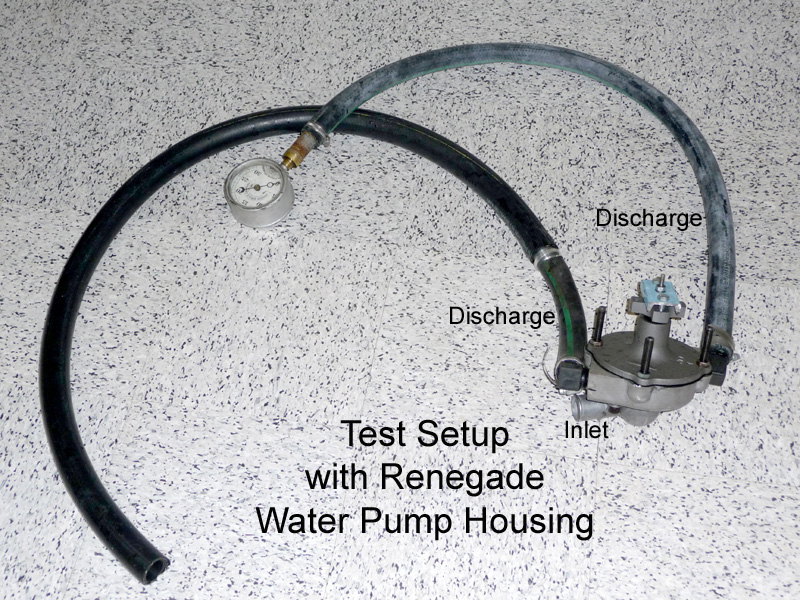 The motive force for spinning the pumps during testing was a 2,500 RPM hand-drill attached to the protruding bolt on the blue-colored channel that you see in the picture. Unfortunately, the drill could not achieve the full 2,500 RPM under load, so I had to settle for whatever it could do. As a result I had to calculate the resulting water pressures at higher RPMs. The calculated results (list image) do seem to correspond to real conditions, indicating very high pressures at dead head conditions - thermostat is closed during cold engine conditions and not having a bypass. Note that a nearly closed thermostat could be experienced under cruise conditions in very mild weather resulting in the same high pressure effect. Based on my experience and many other posts that I have read about failed pump impellers, the high pressure conditions do happen and that’s what results in catastrophic pump failures. The objective of this testing is to find a pump impeller that is more durable (able to withstand dead head pressures) and to possibly produce less pressure without sacrificing much water flow. Note that the Chrysler big block pumps were used on engines running at about 4,000 rpm, and in my case, my 283 SBC can run to over 6,000 rpm. |
| nick mironov |
 May 26 2010, 10:02 AM May 26 2010, 10:02 AM
Post
#24
|
|
nickm   Group: Members Posts: 204 Joined: 12-June 05 From: San Francisco, CA Member No.: 4,264 |
This is the Lineup of the Tested Impellers.
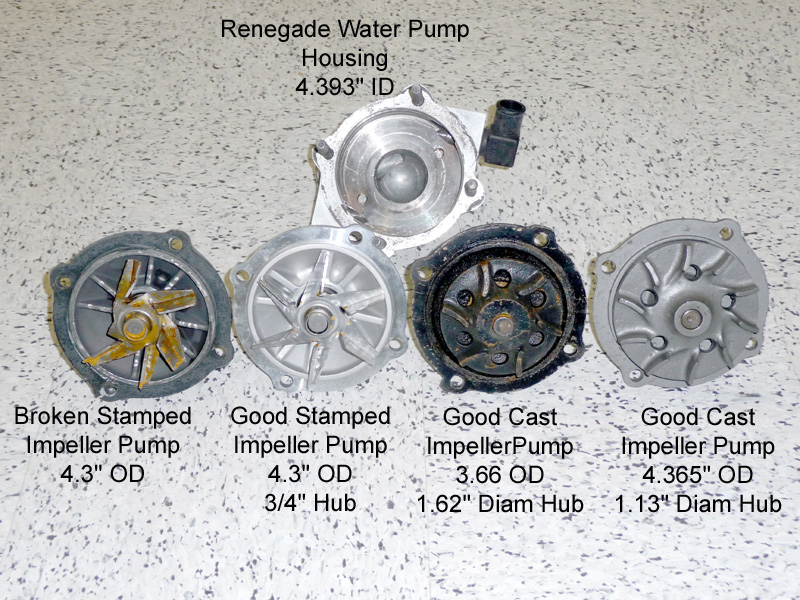 [ [The first one is my failed impeller. I decided to test it just for yucks. It is missing one blade and I un-bent the others so it would at least spin without hitting anything in the housing. It actually worked surprisingly well (except for the violent out-of-balance vibration). The second one is a brand new exact replacement stamped metal impeller with a 4.3” diameter (same as the damaged one). The third one is a cast iron impeller with a 3.66” diameter and 6 blades. SLITS provided this rebuilt one to me for testing. The fourth one is also cast iron impeller with a 4.365” diameter and 10 blades. SLITS also provided this rebuilt one to me for testing. Note that the 4.365” diameter is a tight fit into the 4.393: diameter housing. |
| nick mironov |
 May 26 2010, 10:04 AM May 26 2010, 10:04 AM
Post
#25
|
|
nickm   Group: Members Posts: 204 Joined: 12-June 05 From: San Francisco, CA Member No.: 4,264 |
Failed Stamped Impeller.
The impeller failed during simple city driving. I got about 5,000 miles out of it and never ran it about 3,000 RPM until the engine water temperature was above the thermostat 180 def F setting (per Renegade recommendations). The impeller failed anyway. I suspect that the blades bent a long time ago and finally one broke off, jamming the pump and leaving me stranded (not too far from home). 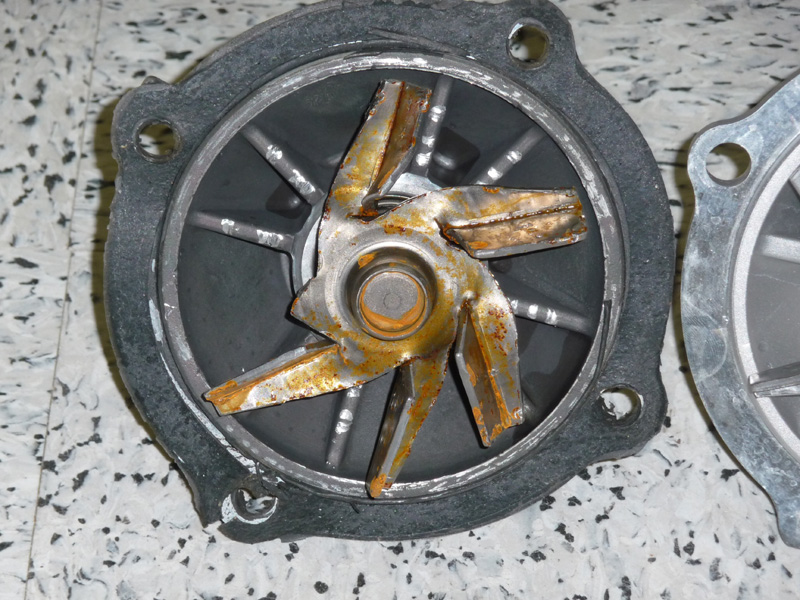 |
| nick mironov |
 May 26 2010, 10:05 AM May 26 2010, 10:05 AM
Post
#26
|
|
nickm   Group: Members Posts: 204 Joined: 12-June 05 From: San Francisco, CA Member No.: 4,264 |
Replacement Stamped Impeller
This is an exact replacement of the failed pump. It fits easily into the housing and has lots of tip clearance. Notice that it is already rusting at the stress points. 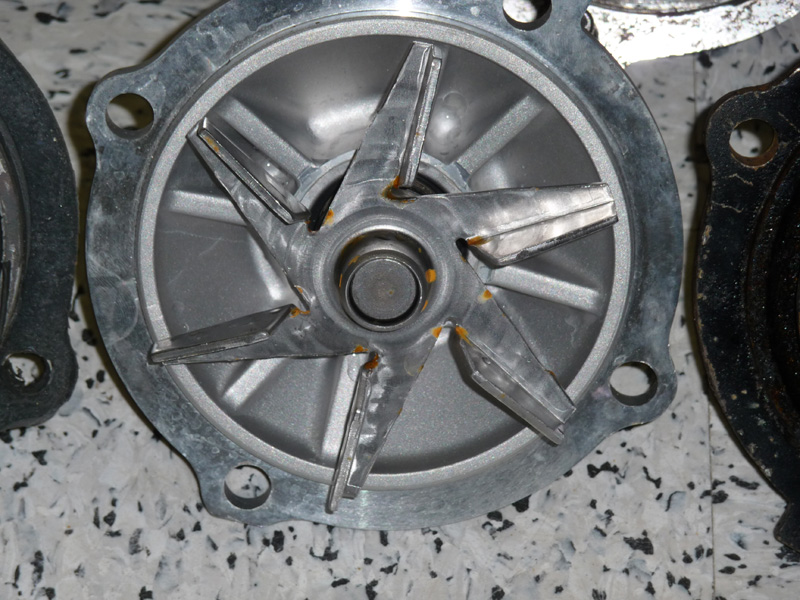 |
| nick mironov |
 May 26 2010, 10:06 AM May 26 2010, 10:06 AM
Post
#27
|
|
nickm   Group: Members Posts: 204 Joined: 12-June 05 From: San Francisco, CA Member No.: 4,264 |
3.66” Diameter Cast Impeller
This is the small diameter cast iron impeller that easily fits into the housing. SLITS says that this one is rated for engines with air conditioning. Odd that one would have a smaller impeller for that… Note the very large hub. The concern was that the large hub would block the housing water inlet and result in very poor flow conditions and/or cavitation. From other posts that I have read, people seemed to have observed this condition and decided to abandon using this impeller. I decided to test it. I was also concerned that the smaller diameter would result in too little flow during idle conditions. 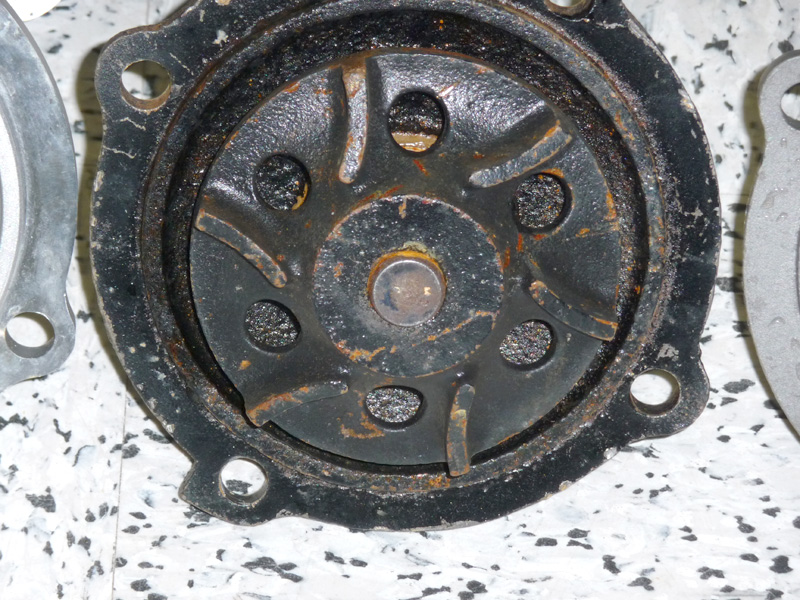 |
| nick mironov |
 May 26 2010, 10:07 AM May 26 2010, 10:07 AM
Post
#28
|
|
nickm   Group: Members Posts: 204 Joined: 12-June 05 From: San Francisco, CA Member No.: 4,264 |
4.365” Cast Impeller
I first thought that the impeller would not even fit into the housing. There was interference until I got it fully pressed in and bolted down. From other posts that I have read, people seemed to have tried to test-fit this kind of impeller (probably without fully installing it) and upon seeing the interference, also abandoned using it. 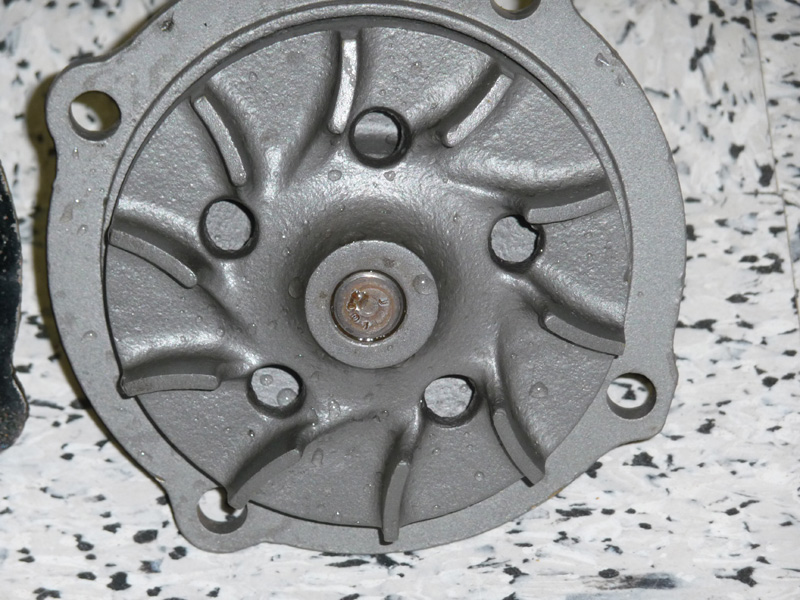 |
| nick mironov |
 May 26 2010, 10:08 AM May 26 2010, 10:08 AM
Post
#29
|
|
nickm   Group: Members Posts: 204 Joined: 12-June 05 From: San Francisco, CA Member No.: 4,264 |
The Housing
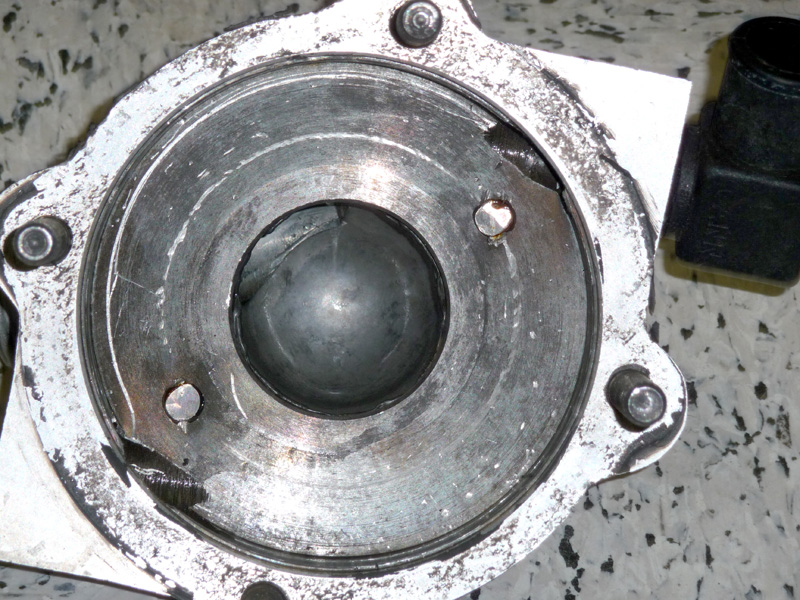 |
| nick mironov |
 May 26 2010, 10:09 AM May 26 2010, 10:09 AM
Post
#30
|
|
nickm   Group: Members Posts: 204 Joined: 12-June 05 From: San Francisco, CA Member No.: 4,264 |
Replacement Stamped Impeller in Housing
Note that there is lots of clearance at the housing inlet due to the open nature of this impeller. 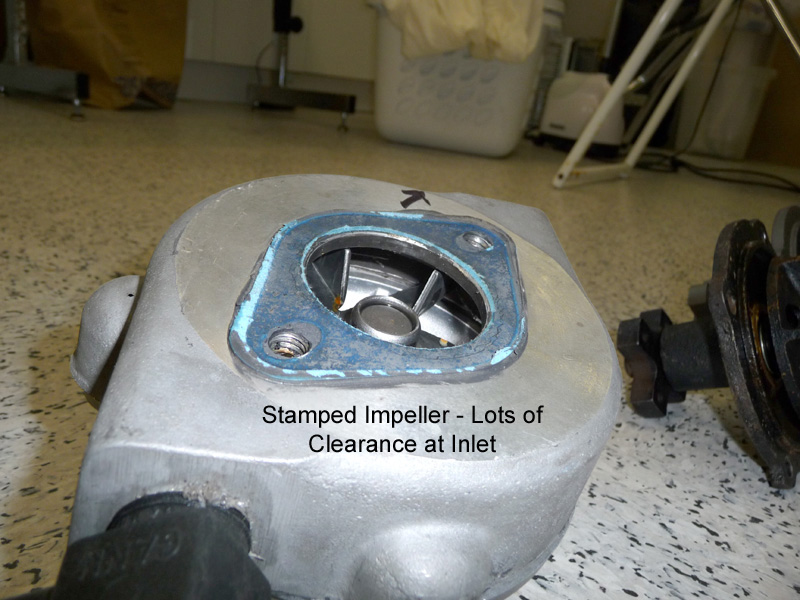 |
| nick mironov |
 May 26 2010, 10:10 AM May 26 2010, 10:10 AM
Post
#31
|
|
nickm   Group: Members Posts: 204 Joined: 12-June 05 From: San Francisco, CA Member No.: 4,264 |
4.365” Cast Impeller in Housing
There is also good clearance at the housing inlet due to the relatively small hub. 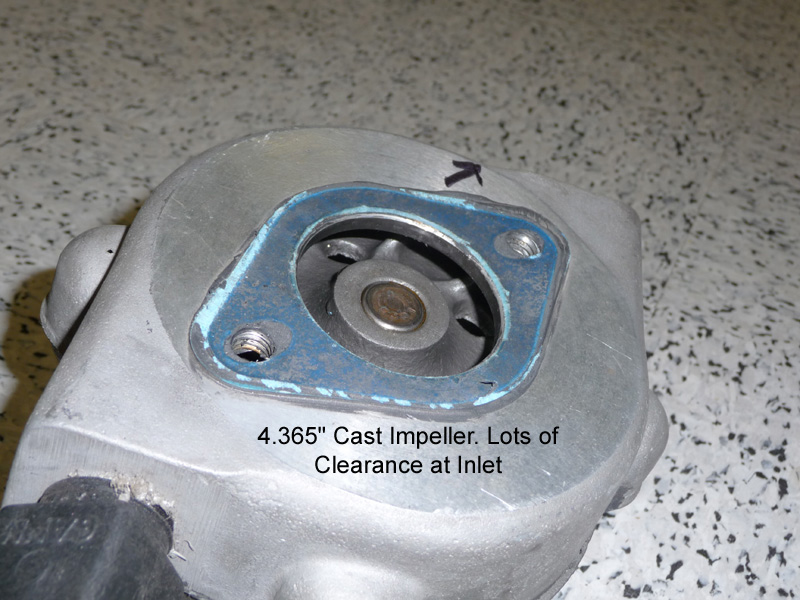 |
| nick mironov |
 May 26 2010, 10:11 AM May 26 2010, 10:11 AM
Post
#32
|
|
nickm   Group: Members Posts: 204 Joined: 12-June 05 From: San Francisco, CA Member No.: 4,264 |
4.365” Cast Impeller in Housing
Note that there is only 0.006” clearance between the bottom of the blade tip and the housing (measures with a feeler gauge inserted into one of the outlets). The clearance between the blade and the housing is also very small (can’t really see it in this picture). I would be very cautious about using this size impeller, because I would be concerned that any out of tolerance housing and/or impeller dimensions, bearing wear, etc. could lead to binding. 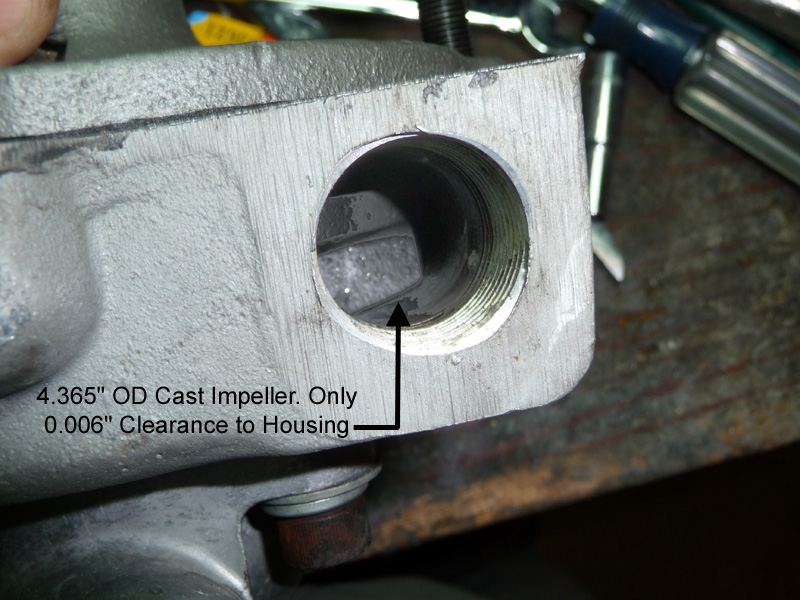 |
| nick mironov |
 May 26 2010, 10:12 AM May 26 2010, 10:12 AM
Post
#33
|
|
nickm   Group: Members Posts: 204 Joined: 12-June 05 From: San Francisco, CA Member No.: 4,264 |
3.66” Cast Impeller in Housing
Note the very small clearance the large hub produces at the housing inlet. I thought that this would be very restrictive and cause flow problems. I was very surprised that it did not and the test results were very good. 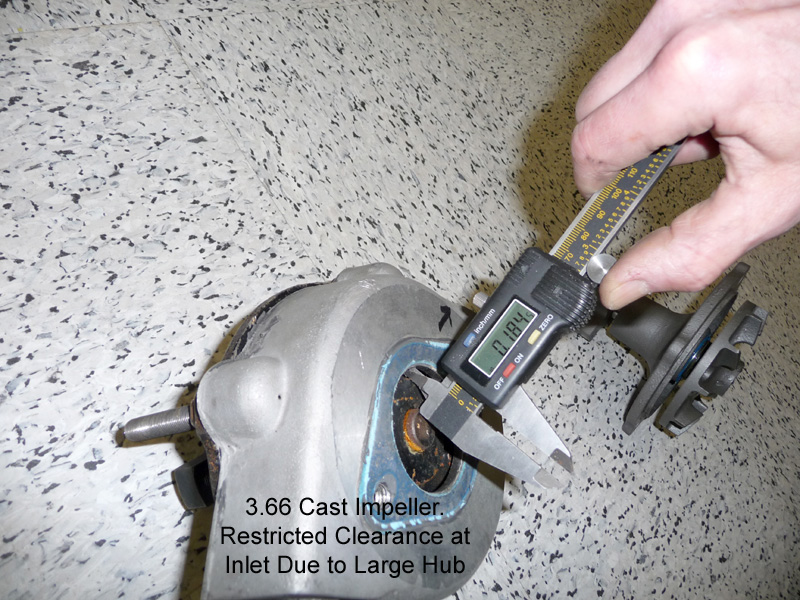 |
| nick mironov |
 May 26 2010, 10:13 AM May 26 2010, 10:13 AM
Post
#34
|
|
nickm   Group: Members Posts: 204 Joined: 12-June 05 From: San Francisco, CA Member No.: 4,264 |
Housing
After I finished testing everything, I cleaned up the housing by buffing out the nicks and burrs, caused by the impeller failure, and beveled the inlet to get better inlet conditions. 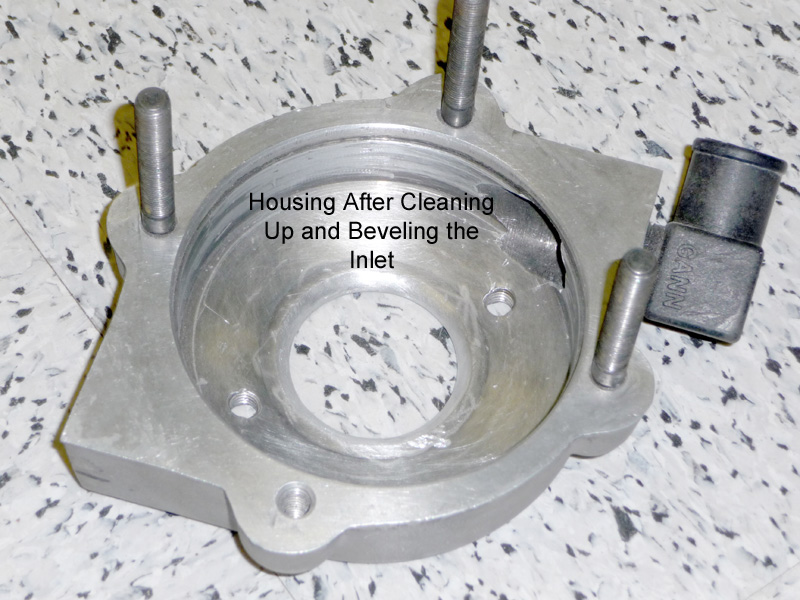 |
| nick mironov |
 May 26 2010, 10:14 AM May 26 2010, 10:14 AM
Post
#35
|
|
nickm   Group: Members Posts: 204 Joined: 12-June 05 From: San Francisco, CA Member No.: 4,264 |
3.66” Cast Impeller in Housing after Beveling the Inlet.
The clearance was increased and the resulting clearance of about 0.25”, while it seems very small, is more than the net free area of the sum of the two outlets. I did not retest the 3.66” impeller after I did this, since it worked so well before beveling. 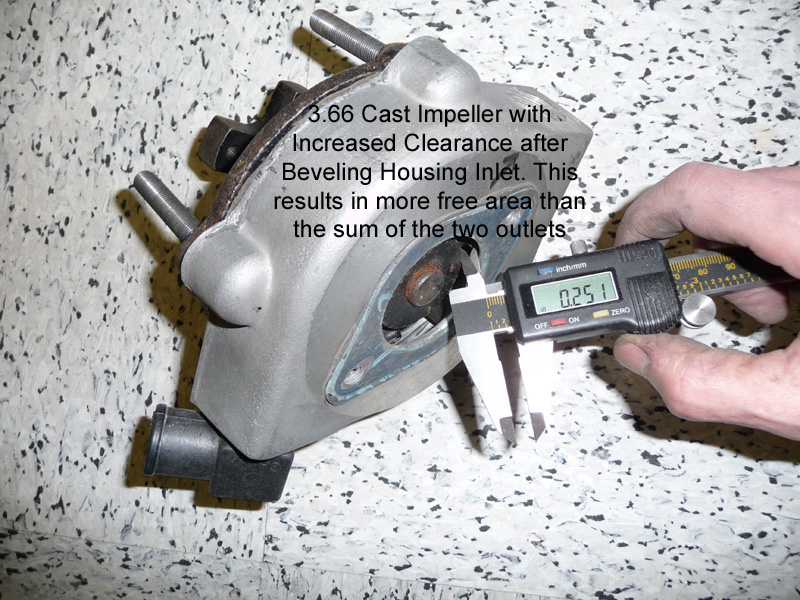 |
| nick mironov |
 May 26 2010, 10:16 AM May 26 2010, 10:16 AM
Post
#36
|
|
nickm   Group: Members Posts: 204 Joined: 12-June 05 From: San Francisco, CA Member No.: 4,264 |
The Results
Since I did not have test equipment to test the pumps at actual motor driven RPMs (idle through 6,000 RPM), I had to settle for low RPM tests and extrapolate out to the higher RPMs. The engine pulley and the pump pulley are the same size (they look the same, I didn’t actually measure them) so the pump RPM is the same as the engine RPM. Since I could not achieve actual performance data, I decided to test only one of the two pump outlets for convenience. I think that if both outlets were testes simultaneously, the flow would not be double, but only about 30% more. The results indicate relative (not absolute) performance of the pumps. See test data below. Broken Stamped Impeller This impeller, even though missing a blade and being mangled, performed surprisingly well (even though it was way out of balance). This means to me that one could have a badly damaged impeller with bent blades, and the pump would still work and one would never even know until a blade came off due to cyclic stressing. Replacement Stamped Impeller This produced the highest flows and pressures. However, highest flows and pressures are not necessarily what we want. We want to keep the pressures moderate so that we don’t burst the hoses or have the pump fail. Note that during dead head testing, the pressure was erratic and bouncing between 6 and 10 PSI. (The other pumps did not do this). This is suggesting to me that something like cavitation might be going on during dead heading. I suspect that this is what is causing the stamped pumps to fail. 3.66” Cast Impeller This pump had the lowest pressure at only slightly reduced flow (even before I beveled the housing inlet). The idle flow was the lowest of the group (as expected), but not as low as I thought it would be. I settled on this pump and also beveled the inlet for better water flow. I did not retest it after beveling the inlet. 4.365” Cast Impeller The tight tip clearance of this pump turned me off. Any small deviation could potentially cause it to bind up. It had good performance, better than the stamped impeller as far as pressure and flow. It was the best looking of (except that the hub appears to be out of round, but did not cause any noticeable vibration). Other Information I decided to install bypass anyway, to a keep the dead head pressures down. Renegade is starting to market a bypass system and I decided to try it. It is very simple. You remove the regular thermostat and install an external Wahler bypass thermostat, connect the discharge to the filler pot (as usual) and run the bypass back to the pump inlet and make the connection with a Tee fitting (pictures later). The Wahler thermostat is for a BMW 2002 or 320i. (W0133-1627641 80 deg C / 176 deg F, W0133-1627306 75 deg C / 167 deg F, W0133-1622197 71 def C / 160 deg F) Cast Iron Pump Sources Slits says that he has 30 cores (3.66 diameter cast iron) that can be rebuilt and sold for $55 plus shipping. This is a very good deal. Although I could find many kinds of stamped and cast impeller pumps on the internet, I could find no information about impeller diameters or any other specific dimensions. And, the designs from the various manufacturers are quite different. You would need to use trial and error to find what could fit into your housing. Judging from the pictures that I saw, the marine big block Chrysler pumps seem to have the smaller diameter. The cast iron impeller pumps that I saw ran in the $125 to $200 range. The stamped impeller pumps ran in the $30 to $90 range. My recommendation – go with SLITS. 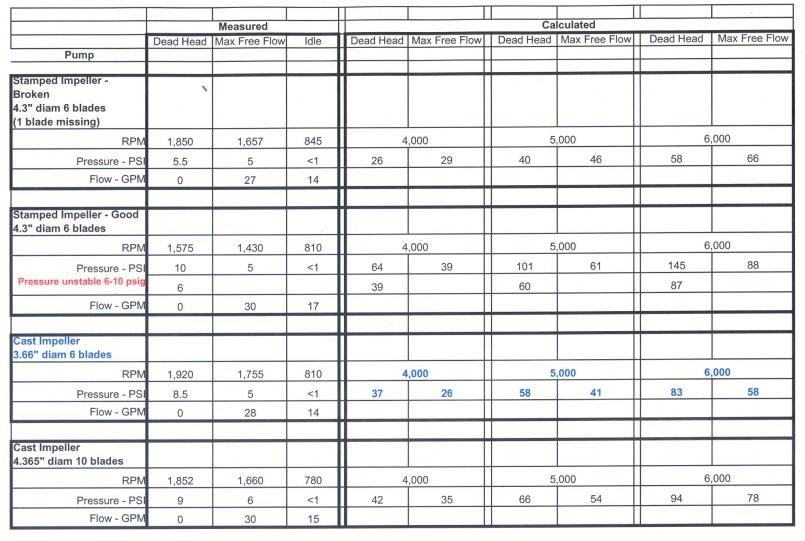 |
| Mike Bellis |
 May 26 2010, 03:29 PM May 26 2010, 03:29 PM
Post
#37
|
|
Resident Electrician      Group: Members Posts: 8,347 Joined: 22-June 09 From: Midlothian TX Member No.: 10,496 Region Association: None 

|
Very nice. Thanks for doing the research for our benefit. I think I should buy one even though I don't need it yet.
|
| TC 914-8 |
 May 26 2010, 11:29 PM May 26 2010, 11:29 PM
Post
#38
|
|
Senior Member    Group: Members Posts: 838 Joined: 23-May 08 From: Sequim, WA Member No.: 9,090 Region Association: Pacific Northwest 
|
Great write up, details and data.
When I was looking for a replacement pump after my failure, I came accross 2 stamped impellers, one 6-blade and one 8 blade., I went with the 8-blade, I do have concerns of overpressurizing my system at high RPM, my outlet hoses from the pump and the hose exiting the engine, swell like a ball park frank when reved up. I don't have a T-stat so dead heading shouldent be a problem. I would be curious on measuring the above pumps gpm and head and plotting a performance curve like OEM water circulating pumps, just a thought. I'll keep your info handy, if my new 8 blade pump fails I'll be going with a cast type. Good job, Thanks, T |
| drive-ability |
 May 27 2010, 07:38 AM May 27 2010, 07:38 AM
Post
#39
|
|
Senior Member    Group: Members Posts: 1,169 Joined: 18-March 05 From: Orange County, California Member No.: 3,782 |
I had a similar problem, I looked around and found a cast impeller. The unit wouldn't fit in the renegade housing. I ended up shaping the renegade housing with a sandpaper hone mounted on my drill press. It took some time and I did get the pump to fit. Works fine...
|
| LvSteveH |
 Jun 1 2010, 04:47 PM Jun 1 2010, 04:47 PM
Post
#40
|
|
I put the Poor in Porsche    Group: Members Posts: 1,080 Joined: 22-April 03 From: Las Vegas, Nevada Member No.: 600 |
This is Scott using Steve's 914 World account for now...
First of all...I have seen the failures that are discussed in this thread. There are several reasons why the failures have increased over the years including lower quality parts used to build the impellers, higher RPM's due to better aftermarket engine technology, cheaper thermostats that don't flow enough volume when open, more debris and blockages in the ageing engine blocks, and just the fact that there are so many SBC 914's and 911's that have finally found the road...and not just a dark corner of the garage covered in dirty laundry and kids toys! My little orange 914 from years back that some of you named "Peal", went through a few water pumps in it's day. I was stranded on a cold windy night on the long State Line grade with just such a failure...so I completely understand the frustration. BUT...it was the cast impeller/water pump that failed that time at the shaft seals and not the typical carnage with the impeller failures. That engine was frequently spun to 6800 RPM and was never driven easily I can assure you. Where we saw the most consistent failures was with customers that revved the engine past about 2500 or 3000 RPM before the thermostat was open. Drilling two or three small holes in the T-stat was the easy way to relieve the pressure a little so the water pump would have a fighting chance. Often the pump would sustain damage after just such a high RPM rap of the throttle when cold, but it would still move some water. BUT, just like the paper clip, eventually the blades would give up and curl themselves around the shaft. In an attempt to help our little water pumps to live longer, we developed an easy fix with a bi-pass T-stat design. Water temps have been consistent, water pump failures seem to be less, hose pressures have been more stable, no need to drill holes in the T-stat, heater core temps have increased on cold days, and it's easy to install. In summary, keeping the RPM's down when your engine is cold, is a good idea in general and may help your water pump last. Installing the cast water pump was a solution I have tried, but they are not completely immune from failure. Different impeller designs will change flow rates that will effect your ability to cool. Using a good quality, high flow T-stat, with two or three small holes drilled, will work very well for this application. Flushing your block and cooling system completely will also increase flow and thermal transfer allowing the engine to cool more efficiently. Installing the new bi-pass system seems to be the next logical step if you are still having issues. On our end, we have looked into impeller suppliers and we think we are using the lesser of all the evils. There is some really bad junk being made out there, but the ones we have are lasting when reasonable care is exercised. If you have any further questions, you are welcome to call Steve or myself here at the shop. Thanks for all the good input here on 914 World without the drama that finds it's way into these boards from time to time. Keep up the good work! Sincerely, Scott >>> Renegade Hybrids www.renegadehybrids.com (866) 498-2421 toll free |
  |
1 User(s) are reading this topic (1 Guests and 0 Anonymous Users)
0 Members:

|
Lo-Fi Version | Time is now: 27th December 2025 - 03:28 AM |
Invision Power Board
v9.1.4 © 2025 IPS, Inc.







